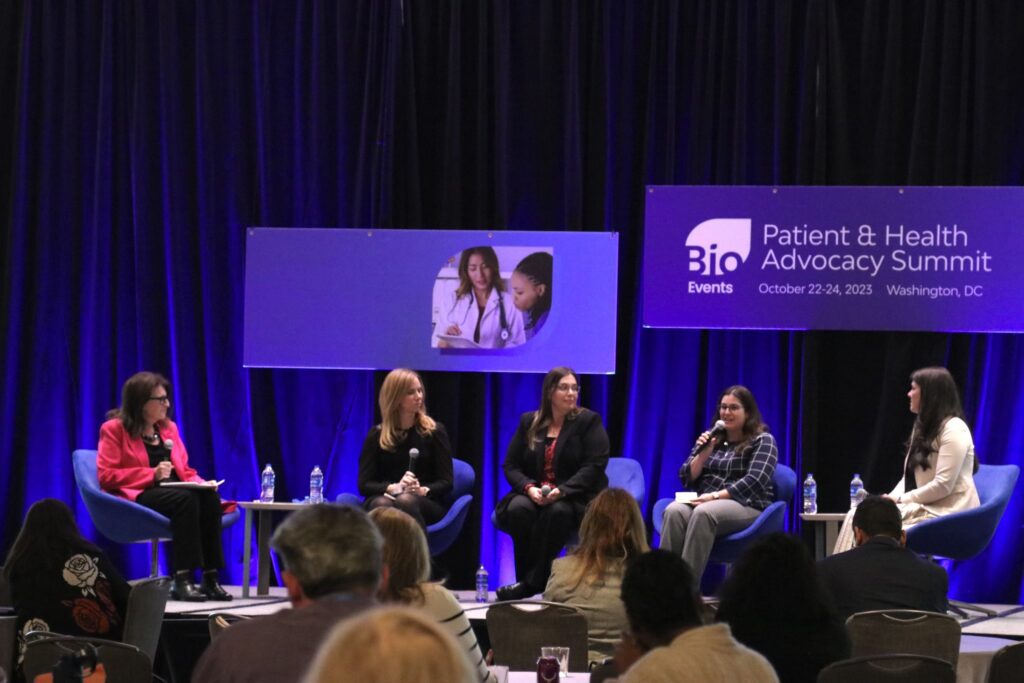Patients’ stories are powerful—especially when it comes to advocacy, agreed panelists at the Biotechnology Innovation Organization (BIO) Patient and Health Advocacy Summit. An October 23 panel focused on “ambassadors as advocates” highlighted the role patients themselves play in successful advocacy and the power of sharing stories.
Moderated by Eve Dryer, VP of Patient Advocacy at Travere Therapeutics, the all-woman panel featured patient advocates who discussed best practices for engaging advocates, especially at the grassroots level.
Listen to patients
Several panelists highlighted the importance of engaging, training, and—above all—listening to patients and getting their feedback on the advocacy process. The National Eczema Association (NEA), for example, has a structured program with advocacy, community outreach, fundraising, and research tracks, and provides its advocates with ample training and resources, said Michele Guadalupe, NEA’s Director of Advocacy and Access.
A mix of in-person and hybrid events can also garner more participation. For example, Shannon Von Felden, Senior Director of Advocacy at the EveryLife Foundation for Rare Diseases, explained the organization’s numerous opportunities for patients to plug into advocacy, including Rare Disease Week on Capitol Hill and Rare Across America, a hybrid program allowing advocates to participate virtually or locally to meet with legislators in their district office. The organization also held its first virtual Youth and Teen Advocacy Day this year, in which advocates ages 10-18 met with their representatives for a virtual training program.
Survey your advocates, panelists agreed. Sara Brown, Director of Governmental Affairs at Prevent Blindness, said the organization asked advocates to complete an evaluation, which made them aware of the need for more consistent and clear communication. This led to Prevent Blindness launching a new advocacy website and bi-monthly newsletter and planning their first in-person event in D.C. for next year. Similarly, the National Psoriasis Foundation has utilized surveys, which has helped NPF build its advocacy and policy program, says President and CEO Leah Howard. This has allowed NPF to build a library of information about patients’ unique challenges, and ensure advocacy is driven by data.
The power of patient stories
Patients’ telling their stories can prompt others to come forward with their own stories—including on Capitol Hill. The panelists agreed that a Member of Congress or their staff are often more likely to share a personal connection to a disease or condition with a member of that specific community, rather than to an employee at an advocacy organization.
“It is empowering when you can support individuals telling their story,” said Howard. NPF provides training to help patients learn how to “tell their story, build the arc, and get the ask across in a sustained time frame.” NEA, similarly, provides technique training and helps patients tailor their stories to fit the timeline of a legislative meeting, while the EveryLife Foundation offers virtual training. Prevent Blindness, meanwhile, has a specific interview style, which helps the patient maintain structure, pace, and timing as well as increase their level of comfort during the process.
“Even though communication with legislators is important, there are other ways to advocate including speaking directly with media, writing letters to the editor, sharing their story on the local news, and through social media,” added EveryLife’s Von Felden.
Helping patients share with one another is key, too. The NPF’s Take Action Program Fall Festival, for example, allows patients with psoriatic disease across the country to come together and tell their stories to one another. “The impact has been amazing and empowering for patients to take ownership of their disease,” said Howard. “Even though patients’ individual experiences are unique, having these stories to retell enables connection within communities.”
Prevent Blindness recently formed a successful partnership with the National Farmworkers Association to increase patient education and information sharing about diabetes, utilizing WhatsApp. They are now working on developing a similar platform in the glaucoma community to foster improved education and earlier detection.
How can organizations ensure underserved and underrepresented populations are heard?
To ensure each patient’s story and experience is represented, NPF’s Howard reached out to the U.S. Food and Drug Administration (FDA), which was looking for absolute diversity within a patient population. NPF considered the varying groups within the psoriatic community including age, gender, race, geographic location, timeline of disease, and severity, for example. After compiling this information, NPF began a promotion with specific patient characteristics. The success of this program was due to the revelation of variation in care and experience identified within the community.
Along with the advocacy community, NPF’s engagement included healthcare professionals, who could provide the necessary information (data and statistics) on their patient population within the community. This provided an extra layer to their findings when searching for a diverse patient population.
EveryLife Foundation has reached out to programs with higher underrepresented populations and works hard to remove barriers for patients—such as by providing travel reimbursements for Rare Disease Week. Similarly, panelists agreed, virtual visits allow for increased opportunities to meet with representatives, putting advocates at ease on a more flexible schedule. Site visits are also suggested as viable options to increase participation among constituents.




